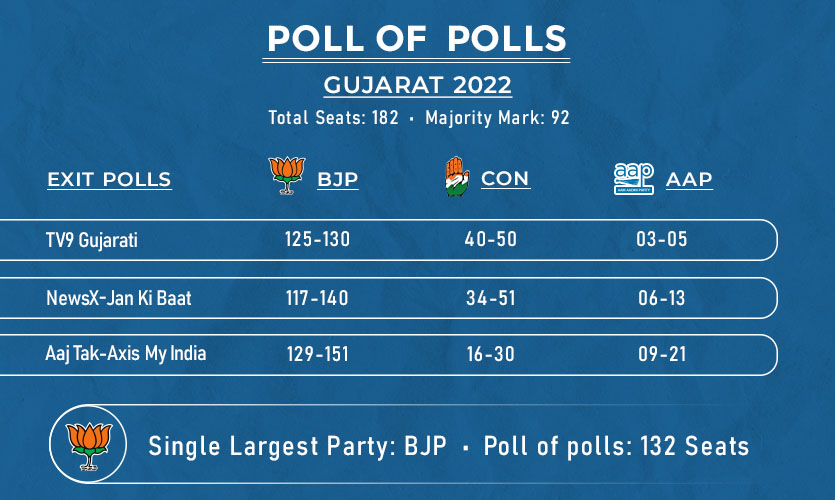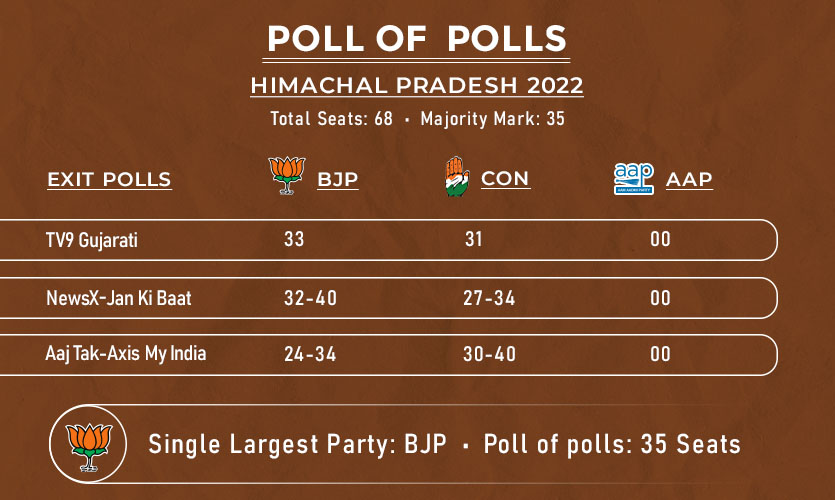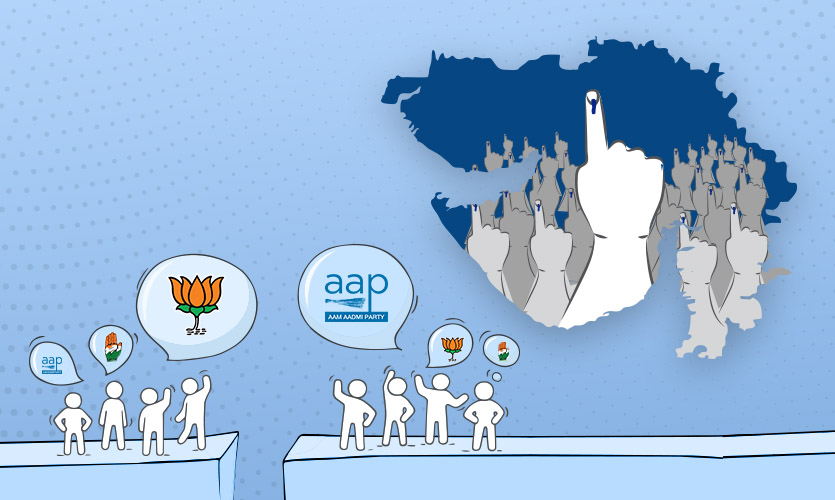Exit polls for Gujarat have predicted a sweeping victory for the Bharatiya Janata Party, highlighting a disappointing scenario for the Congress and little impact created by the Aam Aadmi Party.
What do these numbers say about the public mood?
Poll Of Polls

The election result in Gujarat seems to be predictable enough, with all exit polls projecting a sweeping victory for the BJP (although as a healthy precaution it is important to remember that exit polls often get it wrong). The poll of all exit polls projects a 132-seat win for the BJP, which if achieved would be the highest total for the party in the 182-seat Gujarat Assembly. As per the poll of polls, the Congress and its allies are expected to be a close second with 38 seats, followed by the AAP with 8 seats. The poll by News 24-Today’s Chanakya polls survey has projected the highest total for the BJP at 150, while Zee News-BARC survey has projected the lowest numbers at 110-125, still well above the majority mark of 92.
AAP Debut = Congress Obliteration?
Facing a triangular contest this time in Gujarat, a state that has historically seen only bipolar competition between the BJP and the Congress, the grand old party seems to be in troubled waters. The party had done considerably well in the last election in 2017, when it won 77 seats with a 41 percent vote share, against the BJP’s 49 percent vote share with 99 seats. The Congress has always done well in Gujarat’s rural areas (except Kutch) and the Narmada belt, along with areas with a sizeable Muslim population, and other loyal pockets. Last time’s performance provided renewed hope for the party for the subsequent election. However, with the AAP’s entry on the ground, it is possible that the people are curious about what Mr Arvind Kejriwal has to offer. The party’s focus on Rahul Gandhi’s ‘Bharat Jodo Yatra’, and last minute campaigning by national but non-Gujarati speaking leaders like Kharge standing against Prime Minister Narendra’s Modi’s “kem cho Amdavad?” did not help the Congress’ case in the state.
From the get go, the AAP projected itself as the main opposition to the BJP, attacking the number one party’s stature in its model state. While attacking the number one party in the state with his words, Mr Kejriwal decidedly focused on cutting into the vote bank of the number two. The AAP consciously put aside the urban strongholds of the BJP, focusing especially on the rural and tribal seats held by the Congress. Although most of the Muslim vote in the state has always been in blind favour of the Congress, how the AAP and the All India Majlis-E-Ittehadul Muslimeen would impact the party’s loyal vote bank remains to be seen. The AIMIM is most definitely not ‘the Muslim party’ of the state as per the exit polls, while the Kejriwal’s recent comments aimed at trying to prove his commitment to protect Hinduism may prove discouraging for the community. Some of the Muslim voters, especially women, prefer voting for the BJP, further dividing the vote. The AAP could possibly enjoy substantial tribal and Dalit vote as the communities continue to be unhappy with the ruling BJP over unresolved issues regarding the Narmada rehabilitation and caste discrimination leading to atrocities.
While the AAP did not repeat the Congress’ blunder of not projecting a CM candidate, it also had non-Gujarati speaking national leaders campaigning in the state as opposed to PM Modi and Union Home Minister Amit Shah who always enjoy a homely welcome here. The AAP could also have had it wrong with the strategy of promoting ‘revadi’ in Gujarat, which is most likely ill-suited to all communities in the state. Although it could work with the increasing migrant labourer population, their exposure to Gujarati culture might yet prevail, along with acknowledging the benefits of existent schemes such as the PM Awas, Ujjawala and other yojanas.
A BJP Sweep?
“Look at the development” is the most common justification heard from traditionally BJP voters during pre-polling interviews. Shifting the semiconductor plant from Maharashtra to Gujarat and the recent launch of the Vande Bharat Express on various routes are certainly plus points. Poll predictions for Gujarat have projected a sweeping win for the party today with 132 seats, its best performance since the post-Godhra riots of 2002 when it won 127 seats. Even if it may not retain as many seats, the AAP cutting into the Congress vote share could ensure the BJP’s emergence as the single largest party with a comfortable margin. However, the low voter turnout is a matter of serious concern. Held in two phases on December 1 and 5, the elections saw a turnout of 64.33 percent, the lowest in the last 10 years, with the least voting happening in Ahmedabad’s districts, one of which also includes incumbent CM Bhupendra Patel’s constituency of Ghatlodia. Although the “development” that took place in the shape of smooth roads two days before polling could be a contributing factor in its favour, low voting generally indicates dissatisfaction with the current party in power. Another reason for the low numbers could potentially be the post-COVID brain drain of young professionals, and new voters who either failed to be present for a new responsibility or attempted to voiced their displeasure with the system by not availing the option of NOTA either.
Even though it looks comfortable for the BJP, swing voting in constituencies such as those in Surat and Vadodara could still hurt the party. The 99-77 score last time, even though in favour of the BJP, was taken with a pinch of salt as margins in several constituencies remained close. With central leadership wanting to repeatedly interfere in state administration, the party’s state leadership could face serious backlash, especially with the mismanagement of COVID in the state.
On the brighter side, the Patidar vote in the state is expected to be less divided given the assurance of Bhupendra Patel’s appointment as the chief minister in the case of a win, and Hardik Patel, the leader of the Patidar agitation leaving the Congress to join the BJP earlier this year.
Himachal, MCD Factor

Himachal Pradesh is expected to experience a close contest between the incumbent BJP and the Congress, despite the state having a history of not repeating a party. The poll of polls has projected the BJP to win with a slight margin, attaining 35 seats in the 68-seat assembly, exactly matching the majority mark. While it is difficult to say whether the Himachal polls have had an impact on voting in Gujarat, the vice-versa scenario could definitely be true.
The same can be said for voting in the Municipal Corporation of Delhi (MCD) election. Although the AAP dislodged the BJP after 15 years of control, the score of 134-104 was closer than expected, and even better than the incumbent party was expecting. While it could be argued in the case of the MCD that the leaked tapes of Satyendar Jain’s vacation to Tihar Jail had something to do with the close call, it has definitely been a deciding factor for Gujarat.
As counting is underway, what the public mood in Gujarat is will become more clear by the end of the day, Although in a strictly opinionated observation, it seems that for the Gujarati voter, a known but moral devil in the form of the BJP still works wonders.
The Horus Eye is a weekly column written by Divya Bhan analysing current affairs and policies. This column does not intend or aim to promote any ideology and does not reflect the official position of The Sparrow.
Also read: Can The AAP Successfully Present An Alternative To India’s Aam Aadmi?
Also read: The Many Faces Of The ‘Garvi’ Gujarati Politicians Standing In 2022 Polls










